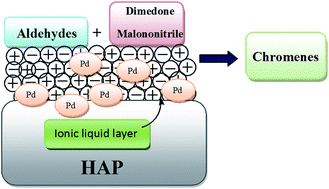One-pot synthesis of various 2-amino-4H-chromene derivatives using a highly active supported ionic liquid catalyst†
Abstract
In this paper, a supported ionic liquid catalyst (SILC) was synthesized by dissolving palladium acetate in [BMIM][OH] and immobilizing it on the surface of HAP. Further, it was characterized by SEM, TEM, TGA, FTIR, AAS and EDAX. This SILC was then used to synthesize various derivatives of chromenes under solvent-free conditions in excellent yields. The products obtained were characterized by 1H NMR, 13C NMR and mass analysis. One of the products, 2-amino-4-(3-nitrophenyl)-6,6,8,8-tetrahydro-7,7-dimethyl-5-oxo-4H-chromene-3-carbonitrile, was also characterized by single crystal X-ray crystallography.


 Please wait while we load your content...
Please wait while we load your content...